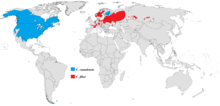
Back Bewer Afrikaans قندس Arabic قندس ARZ Castor AST Drelol (Castor) AVK Qunduz Azerbaijani کاستور AZB Бабёр BE-X-OLD Бобри Bulgarian বীভার Bengali/Bangla
| Beaver Temporal range: Late Miocene – Recent
| |
|---|---|

| |
| North American beaver (Castor canadensis) | |
| Scientific classification | |
| Domain: | Eukaryota |
| Kingdom: | Animalia |
| Phylum: | Chordata |
| Class: | Mammalia |
| Order: | Rodentia |
| Family: | Castoridae |
| Subfamily: | Castorinae |
| Genus: | Castor Linnaeus, 1758 |
| Species | |
|
C. canadensis – North American beaver | |

| |
| Range of the living beavers as of 2016 (including introduced C. canadensis populations in Europe and Patagonia, but missing C. fiber populations in Mongolia and northwestern China, as well as reintroduced populations in the United Kingdom) | |
A beaver is large rodent. It is semi-aquatic: some of the time it lives in water, some of the time it lives on land. Beavers are only found in North America and Europe. In Great Britain, for example, they have been deliberately re-introduced. In Europe, they almost died off, but they are returning. There are beavers living in the Elbe and Rhone rivers, as well as in Bavaria, Poland and Scandinavia. Beavers are known for building and keeping dams in rivers.
Their dams slow down rivers and reduce erosion. The wetlands they create benefit many other species. Special arrangements are needed to let salmon and other migratory fish pass the dams to spawn.